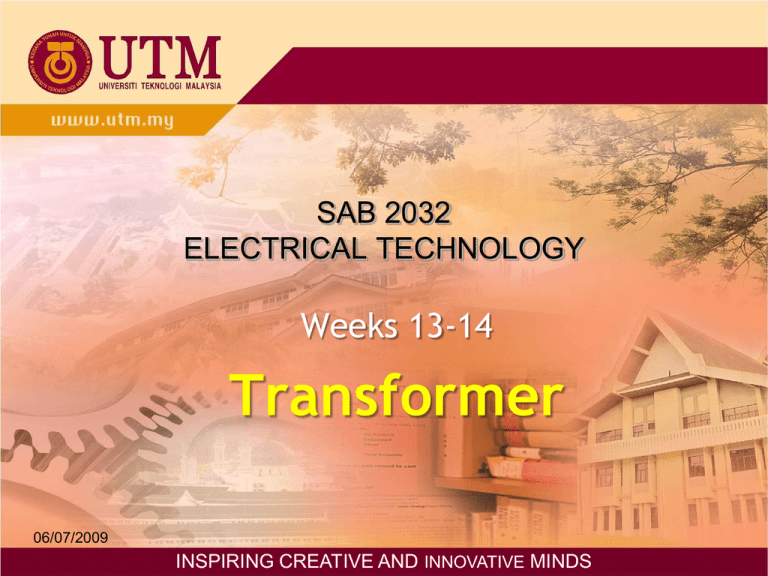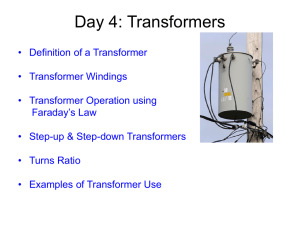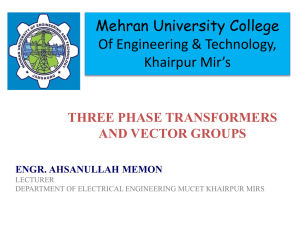Week 13-14-Transf-SAB2032
advertisement

SAB 2032 ELECTRICAL TECHNOLOGY Weeks 13-14 Transformer 06/07/2009 INSPIRING CREATIVE AND INNOVATIVE MINDS Transformers INSPIRING CREATIVE AND INNOVATIVE MINDS Transformers A transformer is a static machine which step voltage/current up or down Unlike in rotating machines, there is no electromechanical energy conversion The transfer of energy takes place through the magnetic field and all currents and voltages are AC Transformer can be categorized as: The ideal transformers Practical transformers Special transformers Three phase transformers INSPIRING CREATIVE AND INNOVATIVE MINDS Transformers INSPIRING CREATIVE AND INNOVATIVE MINDS Transformers INSPIRING CREATIVE AND INNOVATIVE MINDS Transformers INSPIRING CREATIVE AND INNOVATIVE MINDS Transformers Applications of the transformer A typical power system consists of generation, transmission and distribution Power from plant/station is generated around 11-13-20-30kV (depending upon manufacturer and demand) This voltage is carried out at a distance to reach for utilization through transmission line system by step up transformer at different voltage levels depending upon distance and losses Its distribution is made through step down transformer according to the consumer demand INSPIRING CREATIVE AND INNOVATIVE MINDS Transformers Transformer is one of the most useful electrical devices ever invented Functions of transformer: Raise or lower voltage or current in AC circuit Isolate circuit from each other Increase or decrease the apparent value of a capacitor, inductor or resistor Enable to transmit electrical energy over great distances Distribute safely in homes and factories 06/07/2009 INSPIRING CREATIVE AND INNOVATIVE MINDS Principles of Transformer A transformer consists of two electric circuits called primary and secondary A magnetic circuit provides the link between primary and secondary When an AC voltage is applied to the primary winding Vp of the transformer, an AC current Ip will result Ip sets up a time-varying magnetic flux Ф in the core A voltage is induced to the secondary circuit Vs according to the Faraday’s law INSPIRING CREATIVE AND INNOVATIVE MINDS Core Types of Transformer The magnetic (iron) core is made of thin laminated steel sheet. The reason of using laminated steel is to minimize the eddy current loss by reducing thickness There are two common cross section of core which include square or (rectangular) for small transformers and circular (stepped) for the large and 3 phase transformers. INSPIRING CREATIVE AND INNOVATIVE MINDS Configuration of Single phase transformer Primary Winding Multi-layer Laminated Iron Core Secondary Winding H1 H2 X1 X2 Winding Terminals INSPIRING CREATIVE AND INNOVATIVE MINDS 3 Phase Transformer The three phase transformer iron core has three legs A phase winding is placed in each leg 06/07/2009 INSPIRING CREATIVE AND INNOVATIVE MINDS Construction of Transformer This can be divided into 2 types: Core (U/I) Type: Is constructed from a stack of U and I shaped laminations. In a core-type transformer, the primary and secondary windings are wound on two different legs of the core Shell Type: Is constructed from a stack E and I shaped laminations. In a shell-type transformer, the primary and secondary windings are wound on the same leg of the core, as concentric windings, one on top of the other. 06/07/2009 INSPIRING CREATIVE AND INNOVATIVE MINDS Construction of a Small Transformer Iron core Insulation Secondary winding Terminals 06/07/2009 INSPIRING CREATIVE AND INNOVATIVE MINDS Transformer with Cooling System High voltage bushing Oil tank Bushing Low voltage bushing Steel tank Iron core behind the steel bar Cooling radiators Winding Insulation Radiator 06/07/2009 INSPIRING CREATIVE AND INNOVATIVE MINDS The Ideal Transformer For an ideal transformer, we assume ► No losses ► Core is infinitely permeable ► Flux produced by the primary is completely linked by the secondary and vice versa ► No leakage flux of any kind 06/07/2009 INSPIRING CREATIVE AND INNOVATIVE MINDS The Ideal Transformer ► ► ► Primary and secondary posses N1 and N2 turns respectively Primary is connected to a sinusoidal source Eg Magnetizing current Im creates a flux of Φm 06/07/2009 INSPIRING CREATIVE AND INNOVATIVE MINDS The Ideal Transformer ► ► The flux is completed linked by the primary and secondary windings – mutual flux Flux varies sinusoidally and reaches a peak value of Φm 06/07/2009 INSPIRING CREATIVE AND INNOVATIVE MINDS The Ideal Transformer A transformer with more turns in its primary than its secondary coil will reduce voltage and is called a step-down transformer One with more turns in the secondary than the primary is called a step-up transformer 06/07/2009 INSPIRING CREATIVE AND INNOVATIVE MINDS The Ideal Transformer The sinusoidal current Im produces a sinusoidal mmf NIm which in turn creates a sinusoidal flux. The flux induces an effective voltage E across the terminals of the coil Induces Voltages: ► The effective induced emf in primary winding is E1 4.44 fN1m ► Where N1 is the number of winding turns in primary winding, Фm the maximum (peak) flux and f the frequency of the supply voltage 06/07/2009 INSPIRING CREATIVE AND INNOVATIVE MINDS The Ideal Transformer This equation shows that for a given frequency and a given number of turns, Фm varies in proportion to the applied voltage Eg This means that if Eg is kept constant, the peak flux must remain constant Similarly, the effective induced emf in secondary winding: E2 4.44 fN2m 06/07/2009 INSPIRING CREATIVE AND INNOVATIVE MINDS The Ideal Transformer - at No Load E1 N1 a E2 N 2 a = Turn ratio E1 = Voltage induced in the primary [V] E2 = Voltage induced in the secondary [V] N1 = Number of turns on the primary N = Number of turns on the primary 2 INSPIRING CREATIVE AND INNOVATIVE MINDS Ideal Transformer under load: Current ratio Let us connect a load Z across the secondary of the ideal transformer. A secondary current I2 will immediately flow. Does E2 change when we connect the load? 1) In an ideal transformer the primary and secondary windings are linked by the mutual flux, Фm, consequently voltage ratio will be the same as at no load 2) If the supply voltage Eg is kept fixed, then the primary induced voltage E1 remain fixed. Consequently, Фm also remains fixed. It follows that E2 also remain fixed We conclude that E2 remains fixed whether a load is connected or not INSPIRING CREATIVE AND INNOVATIVE MINDS Ideal Transformer under load: Current ratio Let us now examine the mmf created by the primary and secondary windings. First, current I2 produces a secondary mmf N2I2. If it acted alone, this mmf would produce a profound change in the Фm. But we just saw that Фm does not change under load. We conclude that flux Фm can only remain fixed if the primary develops a mmf which exactly counterbalances N2I2 at every instant. Thus, a primary current I1 must flow so that N1 I1 N 2 I 2 06/07/2009 INSPIRING CREATIVE AND INNOVATIVE MINDS Ideal Transformer under load: Current ratio To obtain the required instant-to-instant bucking effect, current I1 and I2 must increase and decrease at the same time In other words, the current must be in phase (a)Ideal transformer under load 06/07/2009 (b)Phasor relationships under load INSPIRING CREATIVE AND INNOVATIVE MINDS Ideal Transformer under load: Current ratio I 2 N1 1 I1 N 2 a I 1 = Primary current [A] I 2 = Secondary current [A] = Number of turns on the primary N 2 = Number of turns on the secondary 06/07/2009 N1 INSPIRING CREATIVE AND INNOVATIVE MINDS Transformer Impedance Z L' VP IP Primary Impedance: Primary impedance in terms of Z L' a 2 Z L secondary impedance : VP aVS Primary Voltage : I I Primary Current : a S P INSPIRING CREATIVE AND INNOVATIVE MINDS Example problem A transformer coil possesses 4000 turns and links an ac flux having a peak value of 2 mWb. If the frequency is 60 Hz, calculate the effective value of the induced voltage E. Ans: 2131V INSPIRING CREATIVE AND INNOVATIVE MINDS Example problem A coil having 90 turns is connected to a 120V, 60 Hz source. If the effective value of the magnetizing current is 4 A, calculate the following: a. The peak value of flux b. The peak value of the mmf c. The inductive reactance of the coil d. The inductance of the coil. INSPIRING CREATIVE AND INNOVATIVE MINDS Real Transformer Leakage Flux: Not all of the flux produced by the primary current links the winding, but there is leakage of some flux into air surrounding the primary. Similarly, not all of the flux produced by the secondary current (load current) links the secondary, rather there is loss of flux due to leakage. These effects are modelled as leakage reactance in the equivalent circuit representation. INSPIRING CREATIVE AND INNOVATIVE MINDS Magnetization Current in a Real Transformer Although the output of the transformer is open circuit, there will still be current flow in the primary windings • • Magnetization current, iM Core-loss current, ic The relation between current and flux is proportional since F NI S S i N INSPIRING CREATIVE AND INNOVATIVE MINDS Magnetization Current in a Real Transformer Therefore, in theory, if the flux produce in core is sinusoidal, than the current should also be a perfect sinusoidal. Unfortunately, this is not true. Current in a transformer has the following characteristics: • It is not sinusoidal but a combination of high frequency oscillation • The current lags the voltage at 900 • At saturation, the high frequency components will be extreme INSPIRING CREATIVE AND INNOVATIVE MINDS Magnetization Current in a Real Transformer Core-loss current: • Eddy current loss- is dependent upon the rate of change of flux • Hysteresis loss - a non linear loss At no-load, the primary windings is known as the excitation current i im ic INSPIRING CREATIVE AND INNOVATIVE MINDS The equivalent circuit of a transformer Taking into account real transformer, there are several losses that has to be taken into account in order to accurately model the transformer, namely: 1- Copper (I2R) Losses 2- Eddy current Losses 3- Hysteresis Losses 4- Leakage flux INSPIRING CREATIVE AND INNOVATIVE MINDS Equivalent circuit of a Real Transformer Equivalent Circuit of a Two-winding, 1-phase: Rc : Core loss component, this resistance models the active loss of the core Xm : magnetization component, this resistance models the reactive loss of the core Rp and Xp : are resistance and reactance of the primary winding Rs and Xs : are resistance and reactance of the secondary winding INSPIRING CREATIVE AND INNOVATIVE MINDS Equivalent circuit of a Real Transformer Impedance Transfer: To model a transformer, it is important to understand how impedance are transferred from one side to another, that is primary to secondary or secondary to primary Impedance transfer is used to calculate the current/voltage easier and also to get the voltage and current ratio for the rest of the calculation In general any impedance transferred from secondary side to primary side must be multiplied by the square of the turn ratio, a2 INSPIRING CREATIVE AND INNOVATIVE MINDS Equivalent circuit-seen from primary side The terminal voltage (Vp,Vs) is not constant and changes depends on the load current. Secondary parameters transferred to primary INSPIRING CREATIVE AND INNOVATIVE MINDS Equivalent circuit of a Real Transformer Equivalent Circuit a) referred to primary side b) referred to secondary side INSPIRING CREATIVE AND INNOVATIVE MINDS Approximate equivalent circuit Approximate equivalent circuit c) Referred to primary side (no exicitation) d) Referred to secondary side (no excitation) INSPIRING CREATIVE AND INNOVATIVE MINDS Approximate equivalent circuit In this model, the parameters from secondary are transferred to primary side. where, Rep and Xep are equivalent resistance and reactance from primary winding side INSPIRING CREATIVE AND INNOVATIVE MINDS Voltage Regulation Is defined as the change in the magnitude of the secondary voltage as the load current changes from the no-load to full load The primary side voltage is always adjusted to meet the load changes; hence V’s and Vs are kept constant. VNL VFL %VR 100 VNL V p aVs aVs 100 V p Vs' Vs' 100 INSPIRING CREATIVE AND INNOVATIVE MINDS Efficiency of Transformer As always, efficiency is defined as power output to power input ratio Pout Pin 100% Pin Pout Pcore Pcopper Pcopper represents the copper losses in primary and secondary windings. There are no rotational losses. INSPIRING CREATIVE AND INNOVATIVE MINDS Example Problem A not-quite-ideal transformer having 90 turns on the primary and 2250 turns on the secondary is connected to a 120 V, 60 hz source. The coupling between the primary and the secondary is perfect but the magnetizing current is 4 A. calculate: a. The effective voltage across the secondary terminals b. The peak voltage across the secondary terminals. c. The instantaneous voltage across the secondary when the instantaneous voltage across the primary is 37 V. Ans: 3000V, 4242 V, 925 V. 43 Example Problem An ideal transformer having 90 turns on the primary and 2250 turns on the secondary is connected to a 200 V, 50 Hz source. The load across the secondary draws a current of 2 A at a power factor of 80 per cent lagging. Calculate : a. The effective value of the primary current b. The instantaneous current in the primary when the instantaneous current in the secondary is 100 mA. c. The peak flux linked by the secondary winding. Ans: 50 A, 2.5 A, 10 mWb 44 QUESTION 06/07/2009 INSPIRING CREATIVE AND INNOVATIVE MINDS Example Problem • A 125 kVA transformer has 500 turns on the primary and 80 turns on the secondary. The primary and secondary resistances are 0.5 Ω and 0.025 Ω respectively, and the corresponding leakage reactances are 2.5 Ω and 0.025 Ω respectively. The supply voltage is 2.2 kV. Calculate: The voltage regulation and the secondary terminal voltage for full load having a power factor of 0.85 lagging 46 Example Problem • The primary and secondary windings of a 400 kVA transformer have resistances of 0.3 Ω and 0.0015 Ω respectively. The primary and secondary voltages are 15 kV and 0.4 kV respectively. If the core loss is 2.5 kW and the power factor of the load is 0.80, calculate the efficiency of the transformer on full load. 47





